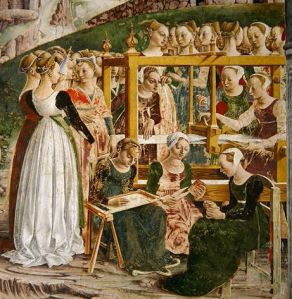athena and her loom: crafting for change
Posted: March 24, 2014 | Author: Sara | Filed under: art, crafts, creative process, feminisms, gender roles, healing, visual art | Tags: Alice Walker, Athena, crafting, crafting the revolution, goddesses, Greek goddess, handicrafts, hands, In Her Hands: Craftswomen Changing the World, knitting, Knitting Behind Bars, knitting circles, sewing, sewing circles, stitches, stitching circles, Toni Morrison |2 CommentsSometimes I get in a serious crafting mood, like if I don’t make something with my hands soon, my overloaded brain will collapse. This happens when I’ve been spending too much time on work that’s based on analysis, problem-solving, and decision-making, when my eyes are bugging out from typing and reading spreadsheets or marginalia, and when my neck is nearly frozen from stress and intense focus. My brain feels like it’s made up of all hard lines and sharp edges that will keep filling up my skull like Tetris pieces until my head explodes.
Because I wrote my undergraduate thesis on goddess archetypes in the novels of Toni Morrison and Alice Walker (and, clearly, am a little bit of a dork), I like to think of this kind of experience as my Athena problem. The Greek goddess of wisdom and war, Athena appears to be all about the mind and the shield, and she even sprang fully formed and covered in armor from the head of Zeus. So when I feel her dragging her sword around in my head, I have to subdue her before she busts out with that Gorgon-covered shield and I’m stuck with her battles forever.
What most people don’t know, however, is that she’s also the goddess of weaving. Yep, wisdom, war, and weaving. She invented the horse-driven chariot but also the loom, which is a reminder that one shouldn’t just be an archetype but a well-rounded, multi-dimensional person. So I subdue her by pulling out her spinning wheel, and next thing I know the armor’s hidden under a pile of warm, smelly wool and she’s humming along to her tapping foot.

The Triumph of Minerva: March, from the Room of the Months, detail of the weavers, Francesco del Cossa
I taught myself to knit from a book about ten years ago when feminists were starting to reclaim the crafts of their grandmothers as a way to redefine what had always been seen as “women’s work.” I’d never really been into crafting before that; it was easy to write it off as an old-fashioned activity for housewives or something. But crafts like knitting were real work. Women knitted and sewed to provide clothing for their families, and they often stitched in groups, where they would support, empower, and inspire each other. If only someone would unearth an old text describing the cultural revolutions that sprouted in stitching circles. For some, of course, crafting was, and is, a livelihood.
I was the laziest knitter for a long time, making only simple projects and leaving them half-finished on a shelf for months. But then I discovered what an antidote knitting is to over-thinking, so now I dig my hands into soft skeins of yarn in many colors and feel sufficiently soothed. There’s something very zen about knitting: the measured click of bamboo needles, slow unraveling of a ball of yarn, trance-like feeling of falling into a pattern.
Pinterest has helped me branch out into other crafts. I’ve fashioned beaded bracelets and necklaces with rope, embroidery floss, and hex nuts. I’ve found new uses for the fabric scraps and triangles left over from my great grandmother’s quilting bin. I’ve recycled old seed catalogues by decoupaging magnets and boxes. I’m a little obsessed with Pinterest. I get ravenous for ideas on how to craft with random things found around my house and in my yard, and it makes me feel very self-sustainable and accomplished. Also, as a writer who has written so much that no one will ever see, it’s a relief to finish a project that’s meant to be shared, and it’s particularly satisfying in an ever-pixelated world.
In fact, crafting is very much about community. I love feeling more connected to history, to the women who came before me, to a handmade life. Crafting, especially with materials found in nature or repurposed from thrift stores or your home, can be a good antidote to corporate industry and overconsumption. There’s a book called In Her Hands: Craftswomen Changing the World, which chronicles the stories of women in twelve countries who turned their lives around by making and selling traditional handicrafts. Then there’s Knitting Behind Bars, which started knitting circles with male prisoners in Maryland, a project that transformed how the men saw themselves and each other. Reading about it will fill your crusty, old heart with joy.
I propose we draw up a new Athena. Perhaps she’s got a skein of yarn attached to her belt or a pair of needles stuffed in the Gorgon’s mouth. We need some way to remember that sometimes she takes off her armor and settles down with a mug of nettle tea and a basket of wool. Sometimes she drops her sword and just crafts the revolution.

Sarita, I love this so much. Felt my own shoulders coming down as I read it! Miss your face. Can we get together soon? xoxo Jenny
Eventually, all things merge into one, and a river runs through it. ~Norman MacLean~ Date: Mon, 24 Mar 2014 19:17:25 +0000 To: redspottednewt@hotmail.com
You are the sweetest. Let’s do some spring stuff!